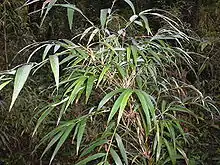| Chusquea quila | |
|---|---|
 | |
| Scientific classification | |
| Kingdom: | Plantae |
| Clade: | Tracheophytes |
| Clade: | Angiosperms |
| Clade: | Monocots |
| Clade: | Commelinids |
| Order: | Poales |
| Family: | Poaceae |
| Genus: | Chusquea |
| Species: | C. quila |
| Binomial name | |
| Chusquea quila | |
Chusquea quila, or Spanish: quila, is a perennial bamboo that grows in the humid temperate forests of Chile and Argentina.
In contrast to most bamboos, it grows as a dense, climbing or decumbent shrub. Its aerial culms are solid, unlike most bamboos, which have hollow culms. Chusquea quila may form pure stands called quilantales occupying all the understory of a forest. Chusquea quila and whole quilantales flower every 10 to 30 years (or 18 to 20 years in some accounts).[1] The seeding that follow the flowering has been associated to mice vermin.[1]
Flour can be prepared from its seeds and its shoots are edible.[2] Chusquea quila species have been historically harvested for seed by indigenous peoples.[1] Mapuche and Pehuenche people are reported to have made flour of the seeds.[1]